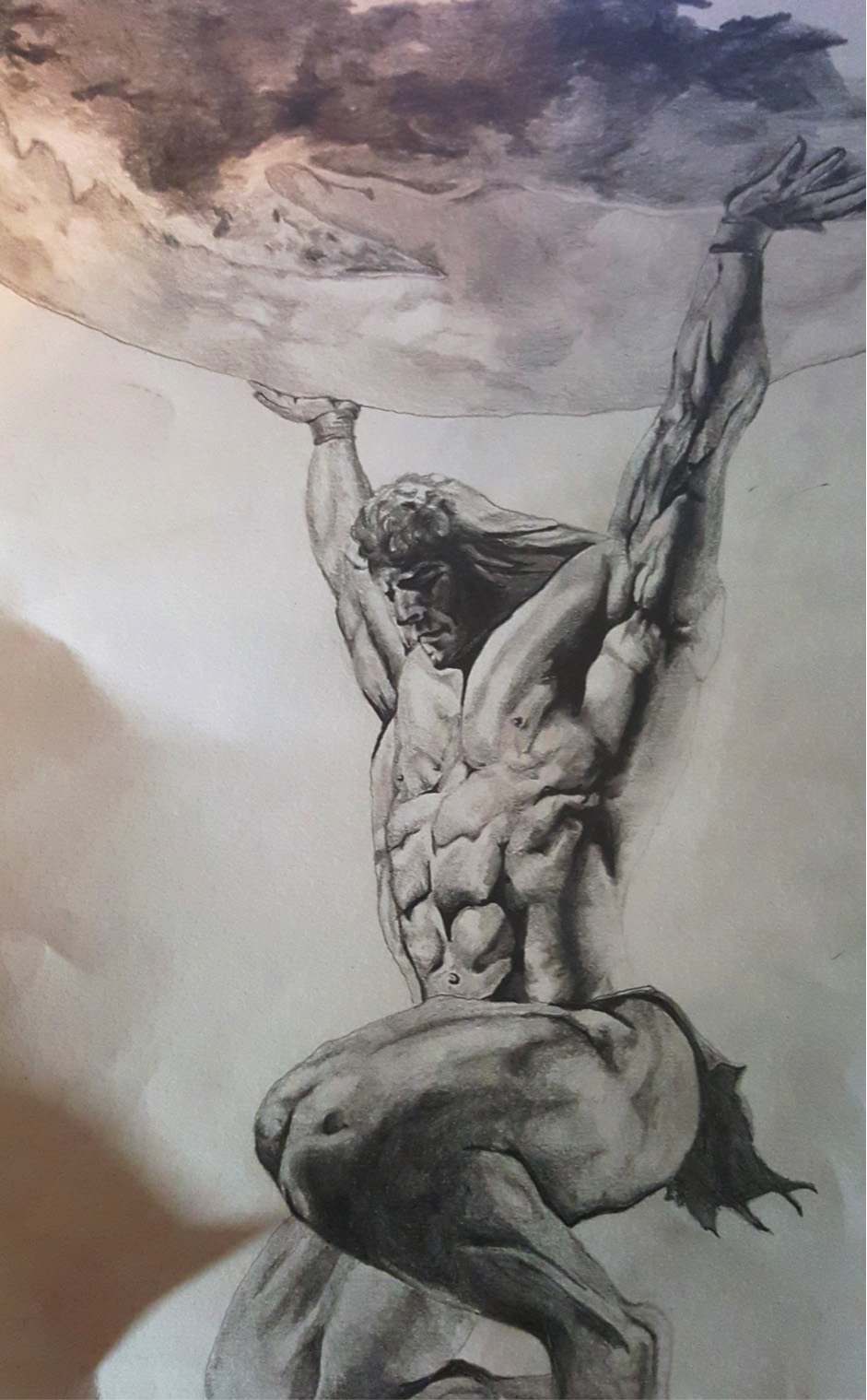I have chosen to illustrate the duty and burden the medical profession which not only emits a desire for resilience but an unquestionable need for it. This piece depicts the raw emotional strength required of a doctor which is conveyed by the muscular physique of the figure carrying his responsibility on his back. The figure’s responsibility is portrayed as the whole world which can be argued as an over exaggeration of a doctors onus, however it can also be argued that a patient’s life can be the entire world to a family member. This shows the amount of trust civilisation will place in the hands of a stranger it would not occur if they had any doubts surrounding the chosen individual’s resilience. I was inspired to draw this piece based on fairy tale from my youth in which Hercules was required to hold up the sky. I was astonished by his physical and emotional strength which I can now relate to a doctor. Furthermore, I believe this picture denotes the strain a doctor can feel with the world in their shoulders by having someone’s life in your hands. The physical condition of the character is a direct comparison with a doctor’s resilience refined and strong. It is obviously egotistical to compare a doctor with a god, however the underlying meaning of the image relates to some of their duties and issues they face.
Given the current reforms concerning the junior doctor contracts, I feel the matter of doctor suicide should not be neglected, especially at this time. It means that doctors will work longer hours so being disconnected from the support of their friends and family which can mentally drain them. This action continues to add the pressures of being a new doctor which only reinforces the notion of necessity for resilience and the importance of mind-body medicine to help cope with these changes. The importance of this cannot be understated to ensure patients reap the greatest benefits from their care. As I was researching for my artwork, I came across many ideas which depict very upsetting and dark images concerning doctor suicide and a lack of mental resilience. However, I chose not to go down this route because, despite the fact that it illustrates the truth of the matter, it does not promote a positive way to overcome the problem. I chose instead to draw an image showing a character overcoming their tribulations which endorses optimism in those who look at the image.

The use of drawing is tremendously effective in emphasising the relief in the muscles. It captures the strain and stress involved. This is further to the simple fact that the figure is naked, which implies that the figure is being laid bare by the difficulty of the challenge. The downturned head and closed eyes bely both the physical and mental strength required to complete the task at hand. The piece is symbolic in a multitude of ways. It manages not only to achieve the obvious comparison of the burden that doctors must bear, but, also, alludes to other more interesting notions. If viewed as Heracles, as it is titled, it can be seen as mere mortals trying to do the job of a god, an intrinsically impossible feat; as set by Eurystheus with the intention of breaking a person. Whilst this may not be the intention of medicine, it is certainly an increasing problem within the medical world. Furthermore, in the mythology, Heracles is only able to take the onus for a short period of time, maybe an observation on the need for a work-life balance. However, if viewed as Atlas, it can be thought of as an eternal struggle to bear the weight of the world upon one’s shoulders. That to falter, for but a second, could bring it all tumbling down. That one slip could end someone’s world. It is unfortunate, but perhaps right, that most of what can be drawn is negative. This is largely due to the nature of Heracles’, or Atlas’, toil as punishment, but an optimistic perspective might arise, if we see that, despite the hardship, he is succeeding. That despite the unfathomable pressure, the insurmountable challenge, the battle is not lost; the world keeps turning.
I am intrigued by how multifaceted the idea of Atlas holding the world is. There are a plethora of different perspectives on the same action, which makes this drawing so compelling. Atlas is both idolized as a god-like figure and as a Titan that can bear the burden of the world. He can also be seen as a kind of antithesis to Sysiphus; Atlas must bear endless responsibility in holding the world for eternity, and thus has the greatest purpose of all people. However, people may share a pessimistic view of this task. He must not falter once, lest the earth shatter as a result of his incompetence. The funny things is; Atlas has an inherently impossible responsibility. Failure is inevitable, the earth will shatter, and civilizations will destruct as a result. the only outcome is loss, and there is no other way out than to endure it.